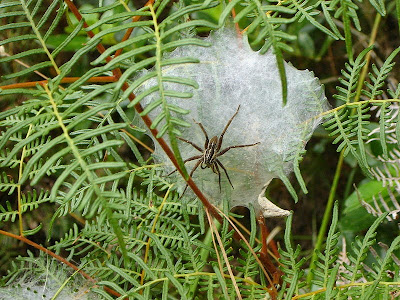Spiders are one of the most familiar groups of invertebrates out there. There's no denying this: everybody knows what a spider is. But for various reasons, the classification of spiders tended to lag a bit behind that of other terrestrial invertebrates. Being softer-bodied than insects, they tend not to exhibit the wealth of features that made many insect groups instantly discernible. To the modern arachnologist's eye, the earliest classifications of spiders can verge on the humorous. Latreille (1802), in his Histoire Naturelle des Crustacés et des Insectes, classified the entirety of what would now be called the araneomorph spiders into a single genus Aranea, divided into sections labelled not with formal names but with schematic diagrams of the arrangement of eyes found in that section.
A few decades later, in 1829 (translated into English in Cuvier, 1831), Latreille was to present a more detailed classification of the spiders, in which they were divided into groups largely on the basis of their life habits. The araneomorphs were hence divided between the Sedentariae, those spiders which captured their prey in webs or laid in ambush, and the Vagabundae, those spiders that actively hunted down their prey. The Vagabundae were in turn divided between two sections: the Citigradae or runners, and the Saltigradae or jumpers. Latreille's classification was subsequently more or less abandoned, as his behavioural groupings failed to line up directly with morphological clusters. Almost by accident, however, those taxa included by Latreille in his Citigradae have continued to be associated, and in modern classifications are classified within the Lycosoidea (Jocqué & Dippenaar-Schoeman 2007).
The lycosoids are, indeed, mostly active hunters. Their behaviour is reflected in the vernacular names of a number of the constituent families: the wolf spiders of the Lycosidae (previously featured here and here), the lynx spiders of the Oxyopidae, the prowling spiders of the Miturgidae. But the correspondence to Latreille's 'araignées loups' is not perfect: the Zoropsidae, for instance, are lycosoids that spin extensive webs. Nor are they mere rapacious hunters: many are devoted parents, carrying and/or guarding their egg-sacs to protect them from predators, and in the case of the Lycosidae even providing a certain degree of care for the newly hatched spiderlings.
One group of lycosoids has even gotten a name for parental care. The nursery-web spiders of the Pisauridae construct protective webs for their babies, containing them within a tent constructed by wrapping sheets of silk around suitable vegetation. When I was a child in New Zealand, I used to be fascinated by the nursery webs constructed by the species Dolomedes minor. Like many pisaurids, this species is associated with water, diving into it to hunt for fish and other small aquatic animals. The females would often build their nursery webs by tying together the ends of nearby rushes. Though it seems a little cruel to my adult self, the younger me loved to pull these webs apart to see the eruption of tiny spiders come scurrying out.
REFERENCES
Cuvier, G. 1831. The Animal Kingdom arranged in conformity with its organization, vol. 3. The Crustacea, Arachnides and Insecta, by P. A. Latreille, translated from the French with notes and additions, by H. M'Murtrie. G. & C. & H. Carvill: New York.
Jocqué, R., & A. S. Dippenaar-Schoeman. 2007. Spider Families of the World. Royal Museum for Central Africa: Tervuren (Belgium).
Latreille, P. A. 1802. Histoire Naturelle, générale et particulière des Crustacés et des Insectes, vol. 3. F. Dufart: Paris.

So where did spiders get their running legs?
ReplyDeleteNew Paper on it:
Anomalocaridid trunk limb homology revealed by a giant filter-feeder with
paired flaps
Peter Van Roy, Allison C Daley & Derek EG Briggs 2015
Nature doi 10.1038/nature14256